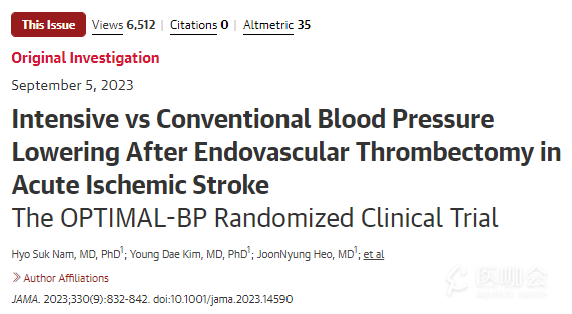JAMA:急性缺血性卒中血管内血栓切除术后强化降压与常规降压的比较:OPTIMAL-BP随机临床试验
本文由小咖机器人翻译整理
期刊来源:JAMA
文献发表时间:2023-09-05
原文链接:https://jamanetwork.com/journals/jama/article-abstract/2808993
关键点内容如下:
问题
急性缺血性卒中血管内血栓切除术成功再灌注后,早期强化血压管理是否能改善预后?
调查结果
在这项包括306名患者的随机临床试验中,39.4%的强化血压管理患者(收缩压目标<140 mm Hg)和54.4%的常规血压管理患者(收缩压目标140-180 mm Hg)在3个月时达到功能独立(改良Rankin量表评分≤2);这代表了显著的差异。
意义
对于接受血管内血栓切除术的急性缺血性卒中患者,在成功再灌注后的第一个24小时内强化降压可能是有害的。
摘要内容如下:
重要性
急性缺血性卒中患者血管内血栓切除术(EVT)成功再灌注后的最佳血压控制尚不明确。
目的
在接受EVT的患者中,确定成功再灌注后第一个24小时内的强化血压管理是否比常规血压管理带来更好的临床结局。
研究设计和参与者
2020年6月至2022年11月在韩国19个卒中中心进行的多中心、随机、开放标签试验,采用盲法终点评估(最终随访,2023年3月8日)。该研究纳入了306例大血管闭塞的急性缺血性卒中患者,这些患者接受了EVT治疗,并接受了改良的脑梗死溶栓治疗,其评分为2B或更高(部分或完全再灌注)。
干预
参与者被随机分配接受强化血压管理,(收缩压目标<140毫米汞柱;N=155)或常规管理(收缩压目标140-180毫米汞柱;n=150,入组后24小时的)。
主要结果和措施
主要结果是3个月时功能独立(改良Rankin量表评分0-2)。主要安全性转归为36小时内的症状性脑出血和3个月内与指示性卒中相关的死亡。
次要结果
根据数据和安全监测委员会(Data and Safety Monitoring Board)的建议,该试验被提前终止,该委员会注意到了安全问题。在306名随机分组的患者中,305名被确认为合格,302名(99.0%的)完成了试验(平均年龄为73.0岁;122名妇女(40.4%))。强化管理组实现功能独立的比例(39.4%)低于常规管理组(54.4%),具有显著的风险差异(-15.1%[95%CI,-26.2%至-3.9%])和调整后的比值比UNK70.56[95%CI,0.33-0.96];P=.03)。症状性脑内出血的发生率在强化组中为9.0%,在常规组中为8.1%(风险差异,1.0%[95%CI,-5.3%至7.3%];调整后的比值比为1.10[95%CI,0.48-2.53];P=.82)。3个月内与卒中指标相关的死亡,强化组为7.7%,常规组为5.4%,(风险差异,2.3%[95%CI,-3.3%至7.9%];调整后的比值比为1.73[95%CI,0.61-4.92];P=.31)。
结论和相关性
在大血管闭塞的急性缺血性卒中患者中,通过EVT成功实现再灌注的患者中,与常规血压管理相比,24小时的强化血压管理导致3个月时功能独立的可能性较低。这些结果表明,急性缺血性卒中EVT成功后应避免强化血压管理。
Key Points
Question Does early intensive blood pressure management improve outcomes after successful reperfusion with endovascular thrombectomy in acute ischemic stroke?
Findings In this randomized clinical trial that included 306 patients, 39.4% of patients with intensive blood pressure management (systolic blood pressure target <140 mm Hg) and 54.4% of those with conventional blood pressure management (systolic blood pressure target 140-180 mm Hg) achieved functional independence (modified Rankin Scale score ≤2) at 3 months; this represented a significant difference.
Meaning Intensive blood pressure lowering during the first 24 hours after successful reperfusion may be harmful in patients with acute ischemic stroke who have undergone endovascular thrombectomy.
Abstract
Importance Optimal blood pressure (BP) control after successful reperfusion with endovascular thrombectomy (EVT) for patients with acute ischemic stroke is unclear.
Objective To determine whether intensive BP management during the first 24 hours after successful reperfusion leads to better clinical outcomes than conventional BP management in patients who underwent EVT.
Design, Setting, and Participants Multicenter, randomized, open-label trial with a blinded end-point evaluation, conducted across 19 stroke centers in South Korea from June 2020 to November 2022 (final follow-up, March 8, 2023). It included 306 patients with large vessel occlusion acute ischemic stroke treated with EVT and with a modified Thrombolysis in Cerebral Infarction score of 2b or greater (partial or complete reperfusion).
Interventions Participants were randomly assigned to receive intensive BP management (systolic BP target <140 mm Hg; n = 155) or conventional management (systolic BP target 140-180 mm Hg; n = 150) for 24 hours after enrollment.
Main Outcomes and Measures The primary outcome was functional independence at 3 months (modified Rankin Scale score of 0-2). The primary safety outcomes were symptomatic intracerebral hemorrhage within 36 hours and death related to the index stroke within 3 months.
Results The trial was terminated early based on the recommendation of the data and safety monitoring board, which noted safety concerns. Among 306 randomized patients, 305 were confirmed eligible and 302 (99.0%) completed the trial (mean age, 73.0 years; 122 women [40.4%]). The intensive management group had a lower proportion achieving functional independence (39.4%) than the conventional management group (54.4%), with a significant risk difference (−15.1% [95% CI, −26.2% to −3.9%]) and adjusted odds ratio (0.56 [95% CI, 0.33-0.96]; P = .03). Rates of symptomatic intracerebral hemorrhage were 9.0% in the intensive group and 8.1% in the conventional group (risk difference, 1.0% [95% CI, −5.3% to 7.3%]; adjusted odds ratio, 1.10 [95% CI, 0.48-2.53]; P = .82). Death related to the index stroke within 3 months occurred in 7.7% of the intensive group and 5.4% of the conventional group (risk difference, 2.3% [95% CI, −3.3% to 7.9%]; adjusted odds ratio, 1.73 [95% CI, 0.61-4.92]; P = .31).
Conclusions and Relevance Among patients who achieved successful reperfusion with EVT for acute ischemic stroke with large vessel occlusion, intensive BP management for 24 hours led to a lower likelihood of functional independence at 3 months compared with conventional BP management. These results suggest that intensive BP management should be avoided after successful EVT in acute ischemic stroke.
医咖会员已正式上线,点击链接https://new.mediecogroup.com/user/vip/categories/,查看会员12项权益!





